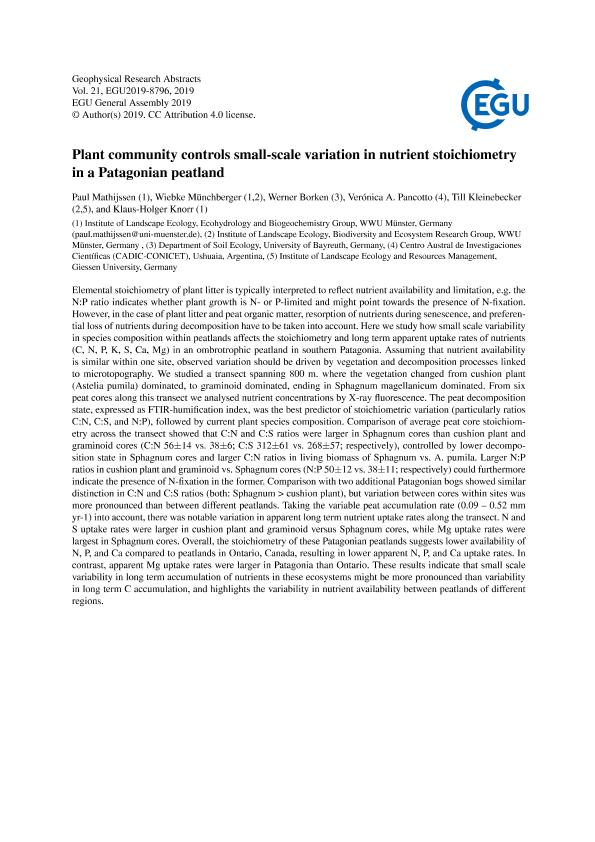Evento
Plant community controls small-scale variation in nutrient stoichiometry in a Patagonian peatland
Mathijssen, Paul; Münchberger, Wiebke; Borken, Werner; Pancotto, Veronica Andrea ; Kleinebecker, Till; Knorr, Klaus Holger
; Kleinebecker, Till; Knorr, Klaus Holger
 ; Kleinebecker, Till; Knorr, Klaus Holger
; Kleinebecker, Till; Knorr, Klaus Holger
Tipo del evento:
Conferencia
Nombre del evento:
21th European Geosciences Union General Assembly
Fecha del evento:
07/04/2019
Institución Organizadora:
Asamblea General de European Geosciences Union;
Título del Libro:
Geophysical Research Abstracts
Título de la revista:
Geophysical Research Abstracts
Editorial:
Copernicus
ISSN:
2391-5447
Idioma:
Inglés
Clasificación temática:
Resumen
Elemental stoichiometry of plant litter is typically interpreted to reflect nutrient availability and limitation, e.g. the N:P ratio indicates whether plant growth is N- or P-limited and might point towards the presence of N-fixation. However, in the case of plant litter and peat organic matter, resorption of nutrients during senescence, and preferential loss of nutrients during decomposition have to be taken into account. Here we study how small scale variability in species composition within peatlands affects the stoichiometry and long term apparent uptake rates of nutrients (C, N, P, K, S, Ca, Mg) in an ombrotrophic peatland in southern Patagonia. Assuming that nutrient availability is similar within one site, observed variation should be driven by vegetation and decomposition processes linked to microtopography. We studied a transect spanning 800 m. where the vegetation changed from cushion plant (Astelia pumila) dominated, to graminoid dominated, ending in Sphagnum magellanicum dominated. From six peat cores along this transect we analysed nutrient concentrations by X-ray fluorescence. The peat decomposition state, expressed as FTIR-humification index, was the best predictor of stoichiometric variation (particularly ratios C:N, C:S, and N:P), followed by current plant species composition. Comparison of average peat core stoichiometry across the transect showed that C:N and C:S ratios were larger in Sphagnum cores than cushion plant and graminoid cores (C:N 56±14 vs. 38±6; C:S 312±61 vs. 268±57; respectively), controlled by lower decomposition state in Sphagnum cores and larger C:N ratios in living biomass of Sphagnum vs. A. pumila. Larger N:P ratios in cushion plant and graminoid vs. Sphagnum cores (N:P 50±12 vs. 38±11; respectively) could furthermore indicate the presence of N-fixation in the former. Comparison with two additional Patagonian bogs showed similar distinction in C:N and C:S ratios (both: Sphagnum > cushion plant), but variation between cores within sites was more pronounced than between different peatlands. Taking the variable peat accumulation rate (0.09 ? 0.52 mm yr-1) into account, there was notable variation in apparent long term nutrient uptake rates along the transect. N and S uptake rates were larger in cushion plant and graminoid versus Sphagnum cores, while Mg uptake rates were largest in Sphagnum cores. Overall, the stoichiometry of these Patagonian peatlands suggests lower availability of N, P, and Ca compared to peatlands in Ontario, Canada, resulting in lower apparent N, P, and Ca uptake rates. In contrast, apparent Mg uptake rates were larger in Patagonia than Ontario. These results indicate that small scale variability in long term accumulation of nutrients in these ecosystems might be more pronounced than variability in long term C accumulation, and highlights the variability in nutrient availability between peatlands of different regions.
Palabras clave:
peatland
,
nutrients
,
microambients
Archivos asociados
Licencia
Identificadores
Colecciones
Eventos(CADIC)
Eventos de CENTRO AUSTRAL DE INVESTIGACIONES CIENTIFICAS
Eventos de CENTRO AUSTRAL DE INVESTIGACIONES CIENTIFICAS
Citación
Plant community controls small-scale variation in nutrient stoichiometry in a Patagonian peatland; 21th European Geosciences Union General Assembly; Viena; Austria; 2019; 1-1
Compartir



